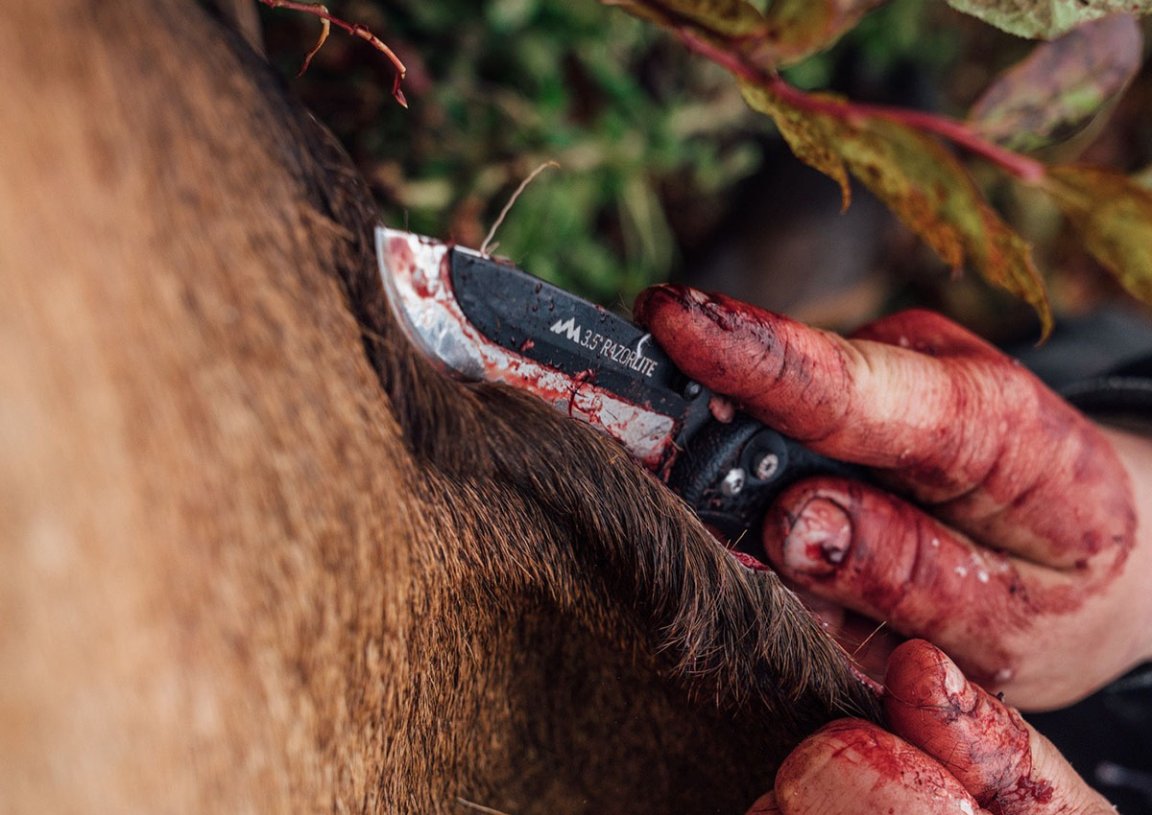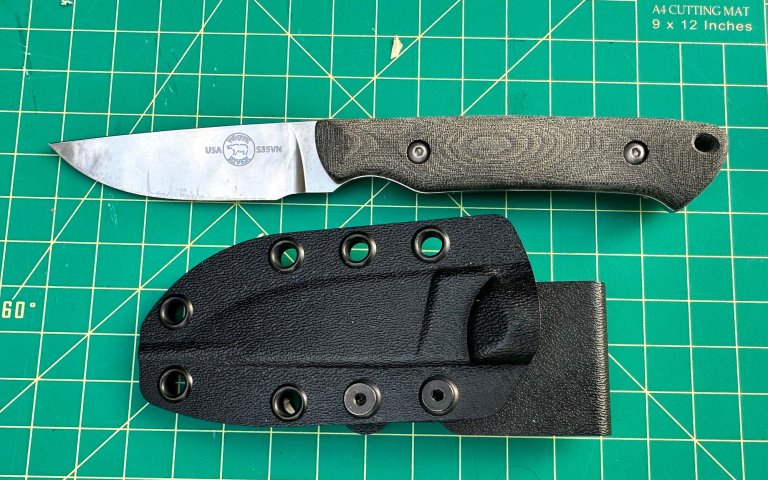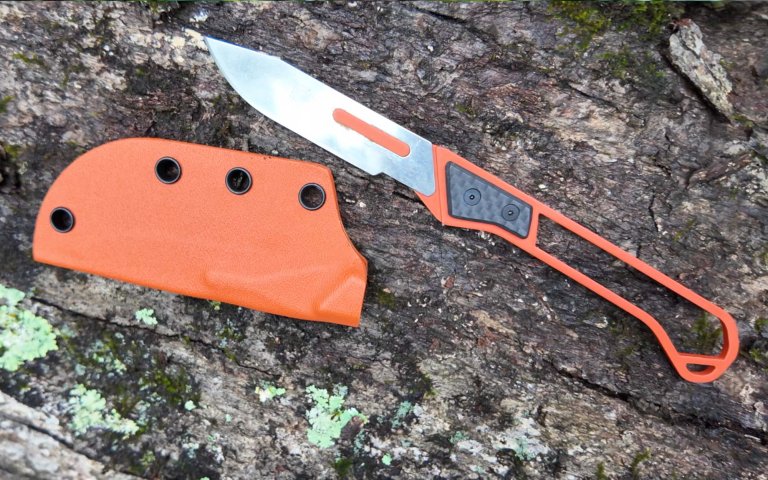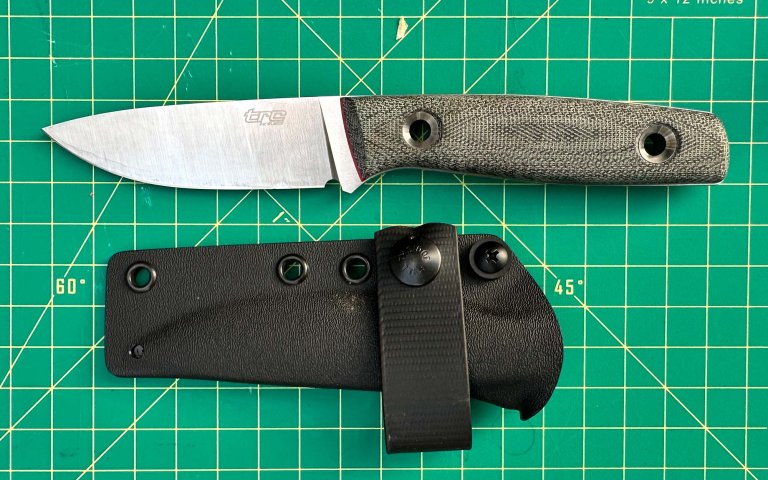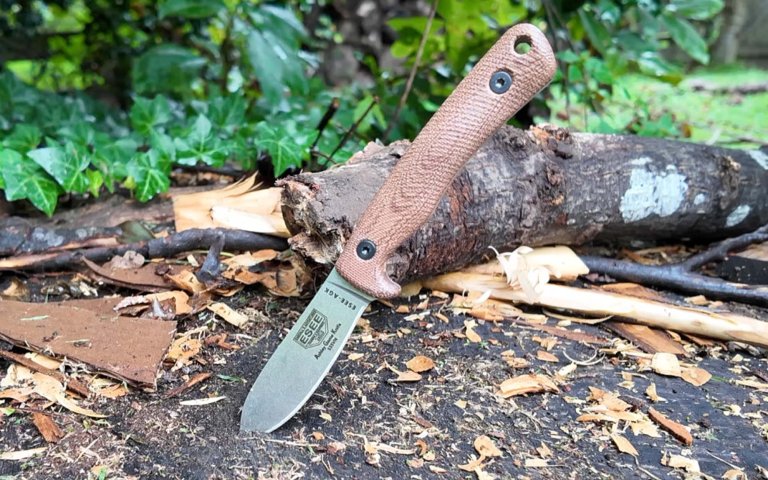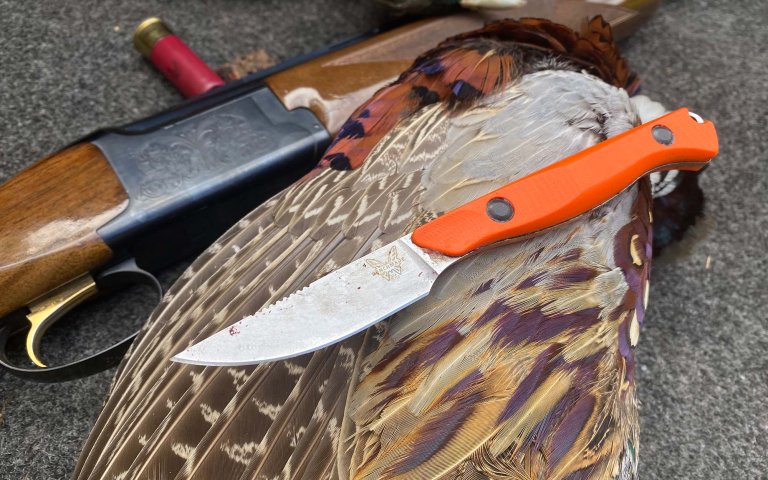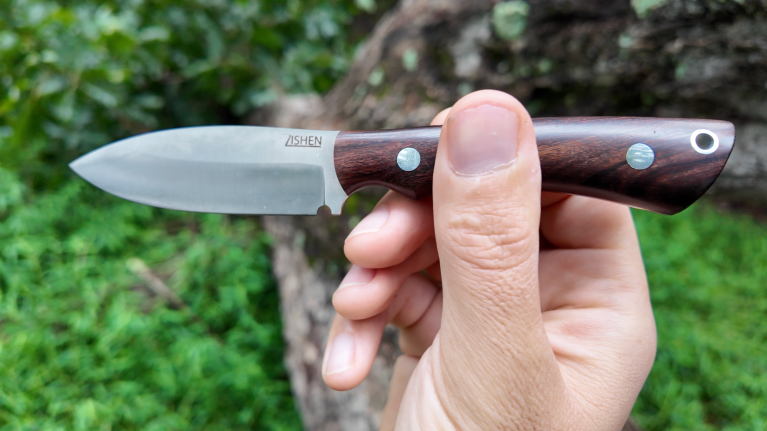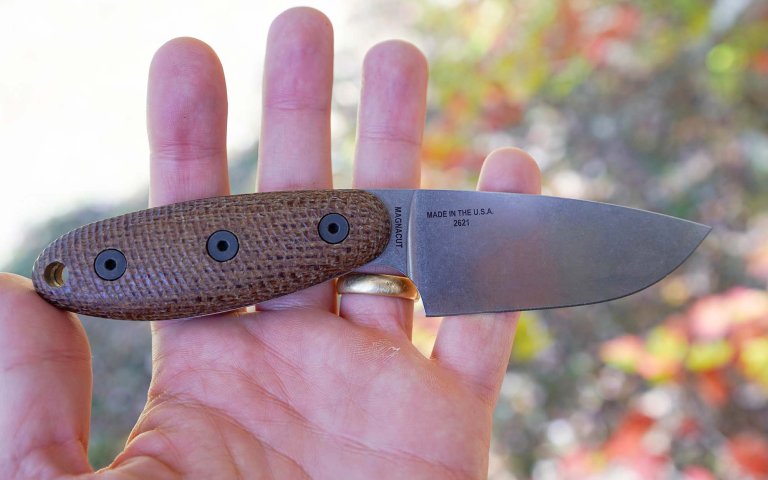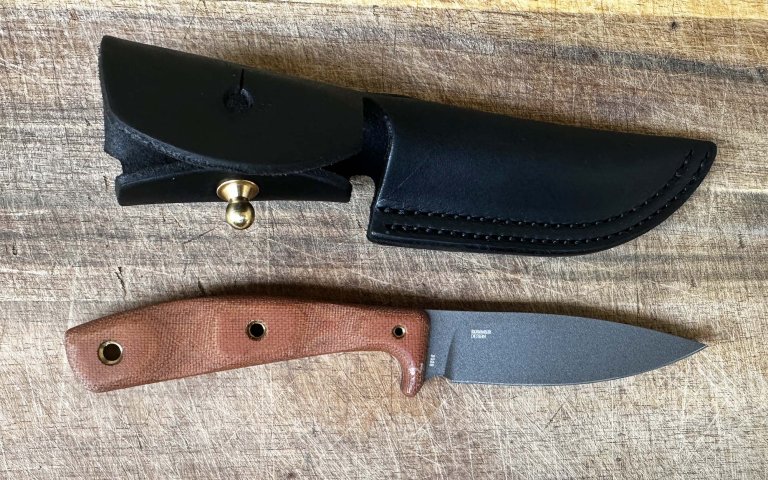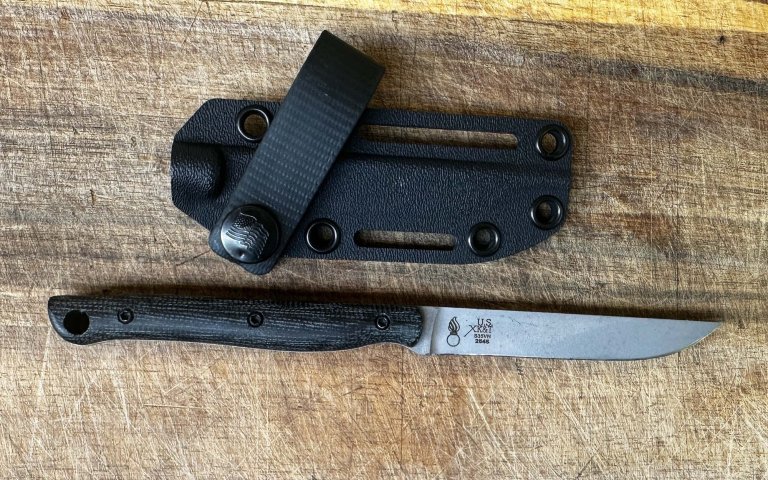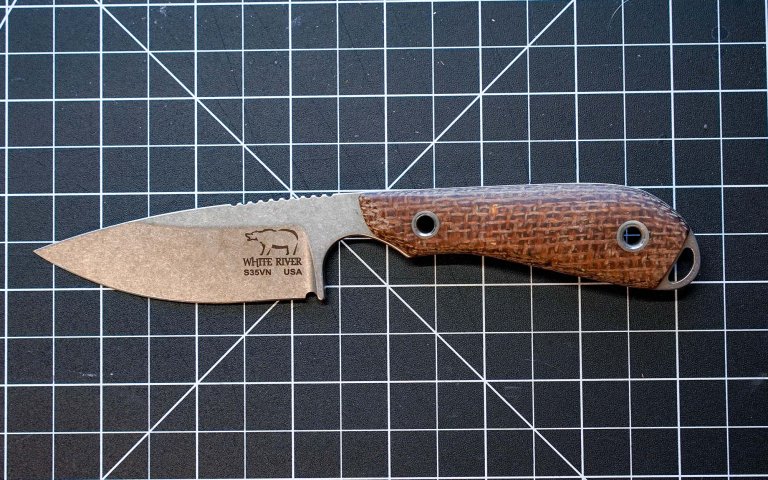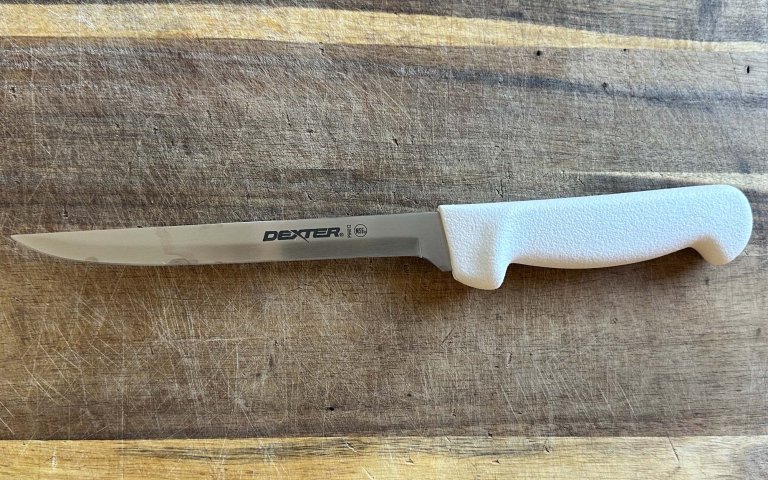We may earn revenue from the products available on this page and participate in affiliate programs. Learn More ›
A hunting knife needs to efficiently process an animal in the field and do that job for many years. That sounds simple enough, and there are hundreds of knives that can do that. But you want the best tool for the job, a precision cutting instrument with the right blend of slicing cutting geometry, a controllable size, and ergonomic grip.
To help you find a hunting knife with those talents, I put 15 fixed blades and five replaceable knives in a head-to-head test. I evaluated their cutting performance, ergonomics, blade steel, sheath, and design. The bulk of my testing involved cutting and deboning a wide variety of meat, which allowed me to directly compare the knives’ performance. Getting the grips bloody and slicked up with fat allowed me to test their ergonomics and see how easy it is to change a replaceable blade while covered in blood.
Here are the top finishers from the test.
- Best Overall: White River Knives Small Game Hunter
- Best Replaceable Blade: Outdoor Edge RazorPro L
- Best Budget Fixed Blade: Buck Alpha Scout Select
- Gear Editor’s Favorite: TRC Classic Freedom
- Best Heavy Duty: ESEE Ashley Game Knife
- Best Lightweight Fixed Blade: Benchmade 15700 Flyway
- Best Premium: Lishen Little Canuck
- ESEE Sencillo
- Boker M.U.K.
- Geber EXO
- CRKT Kommer Soldotna
- White River Knives Exodus 3 (Adventure Craft)
- White River M1 Caper
- Dexter Boning and 7-inch Fillet Knife

Best Hunting Knives: Reviews & Recommendations
Best Overall: White River Knives Small Game Hunter
Pros
- Sculpted handle
- Excellent for slicing and piercing
- Works well for small and big game
Cons
- Some hunters might want a slightly longer blade
Key Features
- Blade Steel: S35VN (58-60 HRC) or MagnaCut (62-64 HRC)
- Handle Materials: Micarta
- Overall Length: 7.25 inches
- Blade Length: 2.62 inches
- Blade Thickness: .130 inch
- Grind: Flat
- Kydex Sheath
- Made in USA
- Price: $160 (S35VN) or $180 (MagnaCut)

I have five things that I look for in a great hunting knife and of all the knives I tested, this is the one that ticks all those boxes. Its blade shape is perfect for field dressing, deboning, and caping. The knife is small enough to be easy to pack, but it has all the capability you need to process an animal in the field. The grind is slicey, which made it one of the top performers in my cut test. S35VN is a great steel because it has excellent corrosion resistance and strikes a nice balance of edge retention and toughness. The big handle allows a full grip and its coke-bottle shape makes for comfortable ergonomics. Its sculpted grip conforms to your hand with a hammer grip, thumb on the spine, or index finger on the spine. I like the ledge at the front of the handle, which is the perfect spot to place your thumb when using an index-finger-on-the-spine grip.
While this knife is called the Small Game Hunter, it by no means is limited to squirrels and rabbits. The 2.6-inch blade is all I need for field dressing and quartering a deer. This year, I lent it to a professional deer butcher who cuts up hundreds of animals per year, and he was impressed with this knife’s cutting ability and ergonomics. If you like the overall design, but want a larger blade I recommend looking at the 3.5-inch White River Hunter.
Best Replaceable Blade: Outdoor Edge RazorPro L
Pros
- Easy to replace blades
- Good blade shape
Cons
- Heavier than some replaceable blade knives
Key Features
- Blade Length: 3.5 inches
- Blade Steel: Japanese 420J2 Stainless
- Nylon pouch
- Weight: 6.4 ounces
- Price: $40
A few years ago I found myself on the side of a mountain with five others trying to break down two elk as quickly as possible. We were hoping to get out of there before tempting the two grizzly bears just a ridge over. Everyone had different replaceable blade knives, but about halfway through the first elk it was obvious, which of the knives was the best — the RazorPro L. Its blades were the easiest to replace and the mounting system was trouble free. Other knives got gummed up and the blades came off, but the RazorPro L chugged through deboning the two elk flawlessly.
In my head-to-head test, the Outdoor Edge RazorPro L once again rose to the top. One of the most important tests I did with the replaceable blade knives was seeing how easy it was to replace the blades while they were all bloody and had meat bits wedged into the voids. I could change out the blades on the RazorPro L in a fraction of the time of the other knives.


While the RazorPro L isn’t the lightest replaceable blade knife. It’s the most trouble-free design I’ve used. I don’t have blades pop off or break and can make it through an animal on one blade. When it’s time to swap a blade you just press the button, slide the blade out, and slide a new blade in. The rubberized handle stays grippy when your hands are covered in blood. The 3.5-inch blade is a good length for balancing maneuverability and cutting efficiency.
Best Budget Fixed Blade: Buck Alpha Scout Select
Pros
- Comfortable handle
- Good value
Cons
- Sheath needs improvement
Key Features
- $68
- 2 ⅞-inch blade
- 420 HC blade
- 2.8 ounces
- Made in USA (Imported Sheath)

The Buck Alpha Scout Select is made in the USA and costs $68. It cuts well, has decent steel, and I like its ergonomics. Although, the knife can be a little slippery when it gets covered in fat and blood. The sheath is this knife’s weak point. Securing the knife in the sheath takes two hands and I’ve yet to get it buttoned up in one try.
If you like the Alpha Scout’s design but want a larger blade, take a look at the Buck Alpha Hunter with a 3.6-inch blade.
Read Next: The Best Camping Knives
Replaceable Blade Knives
Tyto Hollow Bone
Pros
- Crazy light
- Good ergonomics
- Sturdy blade
Cons
- Blades are difficult to change
Key Features
- $165
- 3.1 inch blade
- 1.4 ounces with sheath
- Knife only weighs 0.8 ounces
- Made of grade 5 titanium
- Uses size 60 and 22 blades
The Tyto Hollow Bone is by far the lightest knife I’ve ever tested. I like that Tyto managed to drop this knife’s weight without sacrificing the things that matter like ergonomics and a quality blade. Your typical size 60 blade is thin from edge to spine, and I’ve had several break while using them to quarter an animal. The Hollow Bone blades are wider and more robust so they won’t be as delicate. Replacing blades on the Hollow Bone isn’t as easy as the Outdoor Edge Razor Pro L, but that’s the trade off for a knife that weighs less than a pencil.
Havalon Piranta Edge
- $56 (6 blades)
- 2.75 inch blade
- Stainless steel
Havalon knives are extremely popular because they’re light and cut really well. The main downside with these knives is changing out the blades takes some practice. I don’t recommend trying to change out a blade for the first time while you’re butchering a deer in the middle of the night. The blades are thin and can snap or pop off the handle. So keep that in mind when you’re twisting and prying while trying to loosen a hip joint.
Fixed Blades
Gear Editor’s Favorite: TRC Classic Freedom
Pros
- Light for its size
- Slicey
- Can do any hunting knife cutting task
- Great ergonomics
- Incredible build quality
- Good sheath
Cons
- Not always available
Key Features
- Blade Steel: M390
- Handle Materials: Micarta
- Overall Length: 8.08 inches
- Blade Length: 3.63 inches
- Blade Thickness: .107 inch
- Grind: Flat
- Price: $280
- Made in Lithuania
I bought a stupid number of knives last year and by far my favorite new fixed blade for hunting was the TRC Classic Freedom. The only problem is these awesome knives are so hard to come by, but if you can find one, I recommend picking it up. The blade is the right shape and grind for processing any game animal from start to finish. The grind on this knife is thin, but it’s still very durable. I’ve used the knife to sever squirrel bones by placing the blade on the bone and whacking the spine. The edge took no damage. It’s also fully capable for camp tasks like processing tinder, making feather sticks, striking a ferro rod, food prep, cutting cordage, and whittling tent stakes.
The grip has a ledge near the ricasso where your thumb can get leverage while using a finger-on-spine grip — my most common grip while breaking down a deer. The handle area is skeletonized to reduce weight and it puts the balance point where your ring finger sits. The spine is rounded and very comfortable when putting hard pressure on it.
The blade came insanely sharp and it’s one of the best cutters I’ve tested. The sheath has perfect retention and comes configured for horizontal belt carry. You could remove the belt strap and add a pocket clip if you’d like.
Another reason the Classic Freedom is one of my favorite hunting knives is its incredible build quality. The spine and all the hand contact points are polished and rounded.
The WRK Small Game might the best purpose-built hunting knife, but for a knife that excels at game processing, food prep, EDC, and camp tasks the TRC Classic Freedom is my pick. Moreover, I just really like this knife.
Best Heavy Duty: ESEE Ashley Game Knife
Pros
- Durable
- Good cutter for its steel thickness
- Excellent ergonomics
Cons
- Steel is too thick for detail work
Key Features
- $160
- 3.5 inch blade
- S35VN blade steel
- 5.2 ounces
- 0.150 inch
- Made in USA
If you need a knife that can take a beating, but also field dress, quarter, and de-bone any animal, here’s the knife for you. I batoned and carved wood with this knife and generally mistreated it. The edge didn’t take any damage and in my cut test, it held its own against thinner knives. When deboning, you’ll notice this knife’s steel thickness, but it can get the job done. The grip is one of my favorites of the test and its micarta scales are exceptionally grippy.
Best Lightweight Fixed Blade: Benchmade 15700 Flyway
Pros
- Good ergonomics
- Good edge retention
- Light
Cons
- Not ideal for hard-use tasks
Key Features
- Steel: CPM-154 at 58-61 HRC
- Blade Length: 2.7 inches
- Blade Thickness: 3/32 inches
- Weight: 2.1 ounces
- G10 Handles
- 14-degree bevel
- Kydex sheath
- Price: $180

I’ve put this little knife to work got on whitetails and birds over the last few seasons. It’s one of my favorite hunting knife designs and while it excels at quickly dressing birds, it works equally well as a field dressing knife.
According to Knife Steel Nerds, CPM 154 is tougher than S30V and known for its good edge retention. That toughness makes it a great steel choice for a thin knife (read our guide to knife steel here). In one weekend I used it to field dress and butcher an entire deer without touching up the blade. Then two days later, I used it to butcher pheasants and quail. After my weekend of butchering, the knife could still push cut thin paper.
The blade has a slight drop and plenty of belly for skinning. While field dressing, the fine point and slight drop were perfect for making the initial cut up the deer’s body. It’s also great for making skinning cuts where the knife edge is facing out as you slide the knife under the skin. The length makes it easy to control and when you’re reaching into a chest cavity, it’s easy to know where your knife is. For such a small blade it has a lot of belly, which is great for skinning and deboning.

I rarely hold a skinning knife like a hammer or as I would a survival knife when making a feather stick. I use a pinch grip with my index finger on the knife’s spine. The Flyway’s sculpted G10 grip and spine jimping work well for that method. Especially the jimping that’s three quarters of the way down the blade. It serves not only to prevent slipping, but as an index point so you know where your finger is in relation to the point, even in the dark.
Best Premium: Lishen Little Canuck
Pros
- Great fit and finish
- Very slicey
Cons
- None
Key Features
- $250-$300
- 3.5-inch blade
- 3.2 ounces
- AEB-L blade steel
- Made in USA
I’ve been sorely disappointed by several expensive hunting knives. But the Lishen Little Canuck has excellent fit and finish, cutting performance, and provides good value for the money. Lishen uses several different blade steels and handle materials for his knives, and those factors affect the retail price. You can expect to pay around $250 to $300 for a Little Canuck depending on the materials used. Mine is in dessert ironwood and AEB-L. I like AEB-L for its excellent corrosion resistance and it strikes a nice balance of holding an edge reasonably well while still being easy to resharpen.
ESEE Sencillo
Pros
- Excellent ergonomics in all grips
- Good slicer for skinning
- Works well for EDC and camp tasks
Cons
- Great knife, so-so sheath
- Not the best for deboning
Key Features
- Blade Steel: MagnaCut or A2
- Handle Materials: Brown Burlap Micarta
- Overall Length: 7.25 inches
- Blade Length: 3 inches
- Blade Thickness: 0.12 inch
- Grind: Flat
- Kydex sheath with belt loop
- Unconditional lifetime warranty
- Made in USA
- Price: $150 (A2) or $175 (MagnaCut)
The ESSEE Sencillo costs well under $200, is made in the USA, uses a great steel, and its handle is comfortable no matter how you grip it. Its tall, fully-flat-ground blade is a slicing machine that effortlessly moves through meat, rope, and cardboard. The ergonomics are very secure when you’re using it for hard cutting tasks or your hands are slicked up with water or blood. I especially like that there’s a secure finger stop for making blind cuts deep inside a chest cavity. In addition to being one of the best hunting knives, the Sencillo is a great camp knife and works well for food prep.

For field dressing and deboning I typically like knives with a thinner profile, but for skinning, a wide knife with a lot of belly, like the Sencillo, is perfect. This knife does more than skin though, the Sencillo pierces quite well for such a wide blade and works well for breaking down a deer from start to finish. This knife comes in an A2 or MagnaCut blade, and I think the MagnaCut is worth the extra $25. You’ll get excellent corrosion resistance, toughness, and edge retention with MagnaCut.
The main downside is that the sheath is just OK and it works fine for belt carry, but I wish it was more refined. I’d recommend getting an Armatus sheath if you want to carry it horizontally on your belt or Roac sheath for pocket carry.
Boker M.U.K.
Pros
- Good sheath
- Good cutting performance
Cons
- Some sharp corners on grip
Key Features
- $50
- 2.4-inch blade
- 14C28N steel
- 2.1 ounces
The M.U.K. is an undeniably cool knife, and I was pleasantly surprised it was a performer too. The blade has a ton of belly, which is great for skinning cuts and it worked well for slicing up a backstrap. The ergonomics are good, but the handle could be longer and the back end of the handle comes to a sharp point. The sheath is well made and it comes with a pocket clip, so you can drop the knife in your front pocket.
Gerber EXO MOD Caper
Pros
- Light
Cons
- Slippery handle
Key Features
- $30
- 3.25-inch blade
- 7Cr17Mov
- 1.75 ounces (2.95 ounces with sheath)
The EXO MOD Caper is a slippery knife with very little traction. But it is a light knife and a decent cutter. The sheath is exceptionally good for a budget knife.
CRKT Kommer Soldotna
Pros
- Comfrotable ergonomics
- Good cutting performance
Cons
- Sheath is hard to close
- 1095 steel might be a deal breaker for some
Key Features
- Micarta or walnut handle
- 1095 blade (Cerakote coating)
- 3.48-inch balde
- 0.12-inch blade thickness
- 7.63-inch overall length
- 3.30 ounces
- Made in USA
- $200
The CRKT Kommer Soldotna is made in the USA and has a nice design for all types of butchery. I liked the ergonomics but wish the handle was a touch longer. The blade steel is 1095, which is a high-carbon steel with low corrosion resistance and edge retention.
I did an edge retention test where I tested starting sharpness using a BESS Sharpness Tester, cut a rope ten times, tested sharpness again, resharpened the knife using a field sharpener, and tested sharpness one more time. The Soldotana predicatably did poorly in the edge retention portion, but after a few minutes on a Work Sharp Pocket Knife Sharpener, the edge came right back.
If you don’t want to butcher an entire deer without resharpening, this isn’t the knife for you. But if you want a knife that’s easy to resharpen this is a great one to consider.
White River Knives Exodus 3
Pros
- Easy to carry
- Versatility
Cons
- Not the best dedicated hunting knife due to a lack of slicing ability
Key Features
- Micarta handle
- 2.3 ounces
- 7.2 inches overall
- 3.15-inch blade
- S35VN steel (58-60 HRC)
- Kydex sheath
- $140
- Made in USA
The Exodus 3 was designed to be the knife that you always have on you and can handle a wide variety of outdoor tasks — from fire making to processing game. It has a fairly thick blade for its size and blade height, which doesn’t make for the sliciest cutting geometry. The handle is comfortable in any grip and is smartly designed for its size. It comes with a quality sheath that’s set up for horizontal belt carry. I’d score this as a good knife for hunting and a great knife in terms of utility, purely due to its lack of slicing ability.
The Exodus 3 isn’t the best hunting knife for me, but I find myself carrying it all the time. It’s irresistibly fun to use and carry. It’s small size, versatile ergonomics, and overall utility make it one of my favorite knives. I’d like to try out its larger sibling the Exodus 4 (aka Jackalope) because its taller blade height should make it a touch better at slicing.
White River M1 Caper
Pros
- Light and easy to carry
- Very good ergonomics
- Would make a great hunting knife in addition to its EDC role
Cons
- Jimping is painfully sharp when cutting hard materials
Key Features
- Blade Length: 3 inches
- Overall Length: 7 inches
- Weight: 3.2 ounces
- Includes a Kydex sheath
- Blade Material: S35VN
- Micarta or G10 handles
- Made in USA
- Price: $175
If you want a knife that can double as a daily carry and backcountry companion the Whiter River Knives M1 is one of my top recommendations.
The handle is Croc comfortable and hiking boot secure. It strikes the right balance of being small enough for easy carry, while still allowing a full grip. During testing, the deep choil gave me a lot of control over cuts. While I appreciated the sharp jimping, it was painfully sharp while cutting with a lot of force into wood. However, that sharp jimping is also what you want for a secure grip with bloody hands. It’s among the best slicers I’ve tested. It’ll cut cardboard or quarter an elk with ease.
It comes with a Kydex sheath of good quality, but I would upgrade to an Armatus sheath for daily carry. — Scott Einsmann
Read my test of the best EDC fixed blades for more options.
Best Budget Butchering Knife: Dexter Boning and 7-inch Fillet Knife
Pros
- Comes sharp and easy to resharpen
- Just the right amount of flex
- Great value
Cons
- Handle can get slick when butchering animals that have a lot of fat
Key Features
- Blade Length: 7-inches
- Made in USA
- Price: $13
- Plastic grip
I love expensive knives, but my butchering knives are all inexpensive because they work and I don’t have to be precious with them. The Dexter knives are a staple for professional butchers and I’ve adopted them as my preferred boning and fillet knives. They come sharp out of the package and are easy to touch up on a honing rod.
Once I have a deer skinned and deboned, I use the boning knife to get meat off a deer and then the fillet knife to trim up silver skin and cut portions. The boning knife has just the right amount of flex to get close to bones, but not too much flex that you lose control. For $13 you get a USA-made knife that’s practically perfect for the job it was designed for. — Scott Einsmann
Read Next: Best Knife Sharpeners
How to Choose a Hunting Knife

Steel
We could nerd out on metallurgy, but that’s a topic for another day. Instead, let’s focus on the two main types of steel: carbon and stainless. A carbon steel blade is easier to heat treat, it sharpens quickly, it’s less brittle, and it will rust if kept wet. Stainless steel takes more work to sharpen, won’t rust as easily, holds an edge longer, and is typically harder and, therefore, more brittle.
Size
A 2- to 4-inch knife is ideal for hunting because it’s long enough to efficiently cut while being controllable. The benefits of a longer blade are that it’s more surface area to use, and your blade won’t get dull as quickly as a result. The downsides of a longer blade are that it’ll be heavier and harder to make precise cuts with.
Blade Shape
Clip and drop points are my favorite style for hunting knives because the tip runs in line with the center of the blade, which makes it easy to know where it is. They also have enough belly for slicing cuts. I’d avoid anything with a trailing point because they can easily poke holes in organs while making your entry cut.
Replaceable or Fixed Blade
I used to exclusively use replaceable blade knives and I still use them on occasion. But, I find myself leaning toward a sturdy fixed blade. The reliability of a fixed blade is bonus, and they’re much easier to clean after a long night of butchering. Fat and bits of meat end up in every crevice of a replaceable blade, even the Tyto, and it makes them a pain to clean out. The positives of a replaceable blade knife are that you can go from a dull to a razor edge in seconds. That’s especially beneficial when you need to work quickly due to warm temperatures.
FAQs
Plenty of folks think you need a big knife for hunting big game animals, but that’s simply not true. A small, maneuverable, ultra-sharp blade is more effective for breaking down animals than a giant, unwieldly blade. A 3-inch to 3.5-inch blade is about perfect. Bigger knives with 5-inch blades and up are useful for handling camp work and bushcrafting tasks.
The best knife to gut deer with will have a sharp fine blade and a grip that won’t get slippery when it’s covered with blood. The all-time classic deer gutting knife is probably the Buck Knives’ Buck 110 folder, but the modern version many hunters choose is Havalon’s Prianta or a knive of a similar design.
Final Thoughts on the Best Hunting Knives
A hunting knife can be much more than a tool, it can be an heirloom that passes through the generations. Choose your next knife with longevity and practicality in mind and the next user will thank you for it.
